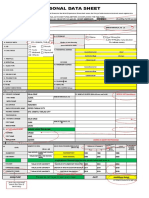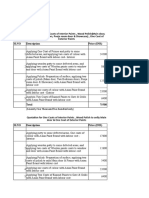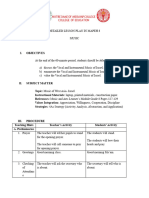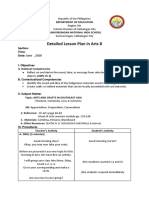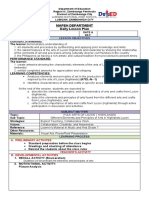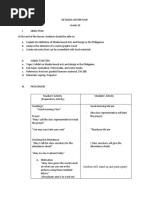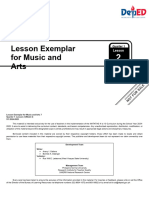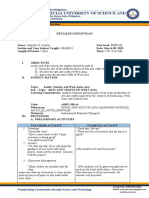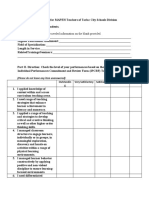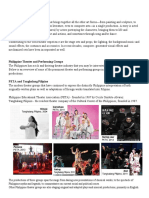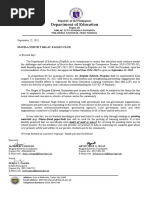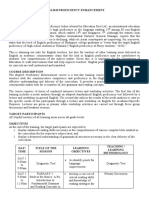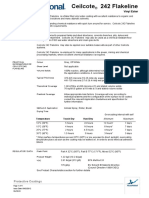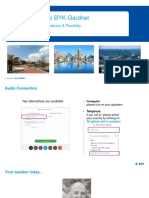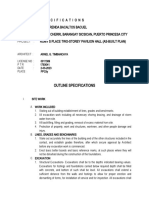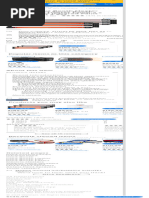Subject/Grade Level: Arts Grade 8 Lesson 1: Introducing The Arts of Southeast Asia Unit I Goal
Subject/Grade Level: Arts Grade 8 Lesson 1: Introducing The Arts of Southeast Asia Unit I Goal
Uploaded by
Nhey CawiganCopyright:
Available Formats
Subject/Grade Level: Arts Grade 8 Lesson 1: Introducing The Arts of Southeast Asia Unit I Goal
Subject/Grade Level: Arts Grade 8 Lesson 1: Introducing The Arts of Southeast Asia Unit I Goal
Uploaded by
Nhey CawiganOriginal Description:
Original Title
Copyright
Available Formats
Share this document
Did you find this document useful?
Is this content inappropriate?
Copyright:
Available Formats
Subject/Grade Level: Arts Grade 8 Lesson 1: Introducing The Arts of Southeast Asia Unit I Goal
Subject/Grade Level: Arts Grade 8 Lesson 1: Introducing The Arts of Southeast Asia Unit I Goal
Uploaded by
Nhey CawiganCopyright:
Available Formats
Subject/Grade Level: Arts Grade 8
Lesson 1: Introducing the Arts of Southeast Asia
Unit I
Goal:
The TDSA learner of the 21st century is a holistic individual who is Christ centered socially oriented and globally competent endowed with a strong
commitment to God and humanity. Mutual responsibility two by two in the learning process through peer critiquing, collaboration and camaraderie. Established
connection between learning and real life situation in the context of the family, community and the country in general.
Graduate Attributes:
SKILLS
Research
Interpersonal Skills
Leadership Skills
Creative thinking
VALUES
Patience
Responsible
Self-Discipline
Flexibility
Topic:
Batik of Indonesia and Malaysia
Objectives/Learning Competencies:
Analyze how the elements of art and principles of design are applied in Southeast Asian arts.
Understand the nature of Southeast Asian arts and crafts and how they affect the life and culture of the people.
Create example of Batik art showing understanding of the elements and principles of art.
Introduction:
The fabric most common to both countries is the Batik. The term “batik” is an Indonesian Malay word, believed to be related to the Malay word “titik”,
which means ‘point’, ‘dot’ or ‘drop’. The “drop” action refers to the process of dyeing the fabric by making use of a resist technique: covering areas of cloth with a
dye-resistant substance (usually hot wax) to prevent them from absorbing colors. This technique is has been taught for over a thousand years leather work.
Activity #1: Video Clip
The teacher will present a video clip about what batik art is.
Body:
Activity #2: Discussion
The teacher will discuss the Batik Art of Indonesia and Malaysia.
1. What is Batik Art?
2. What are the categories of batik designs:
1. geometric motifs
2. free form designs
3. What are some of the motifs in batik design?
4. The two major types of batik printing:
1. Hand drawn and the
2. block-printing type
Conclusion:
Activity #3: Batik Making
Materials:
Canvas or old cotton fabric
Fabric paint or acrylic paint (Latex)
Washable white glue or Elmer's washable blue gel glue
Paint brushes
Plastic wrap or plastic placemat
Procedures: Prepare your fabric by following the steps carefully:
References:
The 21st Century MAPEH in Action 8
Gerard C. Lacia: Ronald V. Solis: Pinky Olivar-Libiran: Corazon Memchero-Romano
Chrismarilene Resontoc-Cabatana:Adelina Pineda-Limos: Aileen C. dela Cruz
REX Book Store
Ms. Lady Mariane D. Patdu
Author
Mapeh Teacher, Our Lady of Ransom Catholic School
You might also like
- Instructions To Fill-Out The PDSDocument9 pagesInstructions To Fill-Out The PDSNhey Cawigan100% (1)
- MUSIC of Mindanao ModuleDocument5 pagesMUSIC of Mindanao ModuleNhey Cawigan79% (24)
- Sspc-Spcom PDFDocument32 pagesSspc-Spcom PDFRoger Schvepper100% (1)
- Lesson Plan in Arts Sculpture 8Document7 pagesLesson Plan in Arts Sculpture 8Catlyn Jane NalzaroNo ratings yet
- Detailed Lesson Plan (DLP) : Knowledge SkillsDocument2 pagesDetailed Lesson Plan (DLP) : Knowledge SkillsJasellay Camomot100% (1)
- 2nd Quarter Exam MAPEH 7Document4 pages2nd Quarter Exam MAPEH 7Nhey Cawigan75% (4)
- Painiter QuotationDocument2 pagesPainiter QuotationSaravanan RajendranNo ratings yet
- Detailed Lesson Plan in Mapeh 7 (Arts)Document6 pagesDetailed Lesson Plan in Mapeh 7 (Arts)Josh Dy100% (1)
- LP in Grade 8 Music Day 4Document8 pagesLP in Grade 8 Music Day 4donnajanedelrosario4No ratings yet
- Lesson 4 Uzbekistan, Kasakhstan and TajikistanDocument68 pagesLesson 4 Uzbekistan, Kasakhstan and TajikistanShaila Marie Baton100% (1)
- Arts and Crafts of Thailand, Cambodia, Laos, VietnamDocument7 pagesArts and Crafts of Thailand, Cambodia, Laos, VietnamJudy Ann MorilloNo ratings yet
- Semi Detailed Lesson Plan in Arts 10 I. ObjectivesDocument3 pagesSemi Detailed Lesson Plan in Arts 10 I. ObjectivesSky GaudiaNo ratings yet
- Detailed Lesson Plan Wayang KulitDocument9 pagesDetailed Lesson Plan Wayang KulitLederly JoseNo ratings yet
- Music 8 Detailed Lesson Plan (Melc 1)Document9 pagesMusic 8 Detailed Lesson Plan (Melc 1)Mica DuhinaNo ratings yet
- Semi Detailed LP in Arts Q3Document5 pagesSemi Detailed LP in Arts Q3allan martizano100% (1)
- Domino LPDocument3 pagesDomino LPBaby ZoeNo ratings yet
- LESSON PLAN IN HEALTH 8 - Family Life: Courtship, Dating, and MarriageDocument4 pagesLESSON PLAN IN HEALTH 8 - Family Life: Courtship, Dating, and Marriagesushienejoy123No ratings yet
- Chance MusicDocument2 pagesChance Musicapi-356211980No ratings yet
- Lesson Plan in Music 8.1Document2 pagesLesson Plan in Music 8.1Jeremy BandolaNo ratings yet
- LP On East Asian MusicDocument5 pagesLP On East Asian MusicNoldan King FranciscoNo ratings yet
- Fundamental Skill LP Grade 7Document3 pagesFundamental Skill LP Grade 7Marlon C. AntonioNo ratings yet
- Lesson PlanDocument16 pagesLesson PlanRhiane StanfordNo ratings yet
- Origami - Grade 8 Lesson Plan MAPEH 2nd QuarterDocument6 pagesOrigami - Grade 8 Lesson Plan MAPEH 2nd QuarterDaniel Jon BERDOSNo ratings yet
- DLP For ST ARTSDocument8 pagesDLP For ST ARTSMaricar Gallamora Dela CruzNo ratings yet
- Lantern FestivalDocument4 pagesLantern FestivalSam Milca NabelonNo ratings yet
- Final Demo - Pe8Document10 pagesFinal Demo - Pe8Usapang NightshiftNo ratings yet
- Grade8 MapehDocument8 pagesGrade8 MapehJeff LacasandileNo ratings yet
- DLP HEALTH8 APRIL17 2023 Emerging and Re Emerging DiseasesDocument6 pagesDLP HEALTH8 APRIL17 2023 Emerging and Re Emerging DiseasesAljun MansalapusNo ratings yet
- Table of Specification Mapeh (Arts) Four 1St Grading 2018-2019Document9 pagesTable of Specification Mapeh (Arts) Four 1St Grading 2018-2019Windy LavarientosNo ratings yet
- Q3 Arts 7 Module 2Document17 pagesQ3 Arts 7 Module 2Alexandra Anne CañeteNo ratings yet
- Detailed Lesson Plan in Mapeh 7Document9 pagesDetailed Lesson Plan in Mapeh 7evelynpanilaglipuraNo ratings yet
- Music: Quarter 2 - Module 2b East Asian MusicDocument19 pagesMusic: Quarter 2 - Module 2b East Asian MusicByron DizonNo ratings yet
- MUSIC LET Asian MusicDocument13 pagesMUSIC LET Asian MusicEleomie AlipoonNo ratings yet
- Quarter 4 Lesson Plan in Mapeh 9 (Arts)Document8 pagesQuarter 4 Lesson Plan in Mapeh 9 (Arts)Katrine Kae G. PradoNo ratings yet
- Semi Detailed Lesson Plan 3rd Quarter ScrabbleDocument2 pagesSemi Detailed Lesson Plan 3rd Quarter ScrabbleMelvin AddunNo ratings yet
- Arts of Asian People (Attires, Accessories, and Artifacts) : Unit IDocument27 pagesArts of Asian People (Attires, Accessories, and Artifacts) : Unit IAnjanette TenorioNo ratings yet
- I. Objectives: School Grade Level Grade 7 SSC Teacher Karla Joy C. Marciano Learning Area MAPEH 7 QuarterDocument3 pagesI. Objectives: School Grade Level Grade 7 SSC Teacher Karla Joy C. Marciano Learning Area MAPEH 7 Quarterkarla joy 05No ratings yet
- LESSON PLAN in MAPEHDocument9 pagesLESSON PLAN in MAPEHJerick MercadoNo ratings yet
- DETAILED LESSON PLAN IN PE 8 (Health Related Fitness Components)Document7 pagesDETAILED LESSON PLAN IN PE 8 (Health Related Fitness Components)Angelbert NavasNo ratings yet
- Detailed Lesson Plan SampleDocument5 pagesDetailed Lesson Plan SampleCiarah Leynes MangcoyNo ratings yet
- I. Objectives: PE10PF-Ia-h-39Document3 pagesI. Objectives: PE10PF-Ia-h-39Ken Genece LlanesNo ratings yet
- Folk DanceDocument2 pagesFolk DanceKimberly Bao Ramos100% (1)
- Detailed Lesson Plan in Physical Education Grade 8 ObjectiveDocument11 pagesDetailed Lesson Plan in Physical Education Grade 8 ObjectiveCrystal Castor LabragueNo ratings yet
- GRADE 8 11-23 Musical Instruments of JapanDocument4 pagesGRADE 8 11-23 Musical Instruments of JapanCristine Joy GumbaNo ratings yet
- Detailed Lesson PlanDocument2 pagesDetailed Lesson PlanREGIE MHAR BELAMIDE100% (1)
- Semi Detailed Lesson Plan in Mapeh 7Document2 pagesSemi Detailed Lesson Plan in Mapeh 7Rou Ann NavarrozaNo ratings yet
- Grade 8 Music Wayang Kulit LessonplanDocument2 pagesGrade 8 Music Wayang Kulit LessonplanRob Casidsid50% (2)
- Grade 7 PE DLL Week 1Document10 pagesGrade 7 PE DLL Week 1Pagsibigan PONo ratings yet
- Detailed Lesson Plan Palawan MusicDocument7 pagesDetailed Lesson Plan Palawan MusicJoy AlviorNo ratings yet
- Arts 10.3Document26 pagesArts 10.3milyuNo ratings yet
- Arts Lesson Plan Q1 Melcs 1Document6 pagesArts Lesson Plan Q1 Melcs 1Donna RomeraNo ratings yet
- LP LocomotorDocument3 pagesLP LocomotorAngelica Bautista50% (2)
- Learning Exemplar in MAPEH-Arts Week 8Document2 pagesLearning Exemplar in MAPEH-Arts Week 8Jhexlyn Anndrei AlianoNo ratings yet
- DETAILED LESSON PLAN in ARTSDocument6 pagesDETAILED LESSON PLAN in ARTSYvonne Gajudo0% (1)
- Lesson Plan - Mapeh 8 - FutsalDocument6 pagesLesson Plan - Mapeh 8 - FutsalPaul Jeremy FuerzasNo ratings yet
- JEROME-MATOTE-MUSIC-8-Japanese TheaterDocument3 pagesJEROME-MATOTE-MUSIC-8-Japanese Theaterjerome matoteNo ratings yet
- LPDocument3 pagesLPJasmin Goot Rayos100% (1)
- Chinese Peking OperaDocument5 pagesChinese Peking OperaClarisse Ingles Custodio100% (1)
- Lesson Plan MAPEH 8: Responsible Parenthood: I. ObjectivesDocument3 pagesLesson Plan MAPEH 8: Responsible Parenthood: I. ObjectivesKian Paolo ManolesNo ratings yet
- 4a's Detailed Lesson Plan in Grade 9 - Arts A. Learning Competency/iesDocument7 pages4a's Detailed Lesson Plan in Grade 9 - Arts A. Learning Competency/iesANGELCIA VILANo ratings yet
- Detailed LP JapanDocument4 pagesDetailed LP JapanMarive Kawabata OperioNo ratings yet
- DLP in DominoDocument7 pagesDLP in DominoSamantha AceraNo ratings yet
- Q1 - LE - Music and Arts 7 - Lesson 2 - Week 3Document15 pagesQ1 - LE - Music and Arts 7 - Lesson 2 - Week 3Andrea Audine100% (1)
- DLP Grade 8 Lesson 6 (Arts and Crafts of West AsiaDocument6 pagesDLP Grade 8 Lesson 6 (Arts and Crafts of West AsiaIelle CGNo ratings yet
- Subject/Grade Level: Arts Grade 8 Lesson 1: Introducing The Arts of Southeast Asia Unit I GoalDocument3 pagesSubject/Grade Level: Arts Grade 8 Lesson 1: Introducing The Arts of Southeast Asia Unit I GoalNhey CawiganNo ratings yet
- PDS Correct TemplateDocument8 pagesPDS Correct TemplateNhey CawiganNo ratings yet
- BE Form 4 DAILY ATTENDANCE OF VOLUNTEERS 1Document41 pagesBE Form 4 DAILY ATTENDANCE OF VOLUNTEERS 1Nhey CawiganNo ratings yet
- Questionnaire For MAPEH Teachers of Tarlac City Schools DivisionDocument4 pagesQuestionnaire For MAPEH Teachers of Tarlac City Schools DivisionNhey Cawigan100% (1)
- RPMS - Portfolio - Design - Mapeh DeptDocument19 pagesRPMS - Portfolio - Design - Mapeh DeptNhey Cawigan100% (1)
- Philippine Theater and Performing Groups: Quarter IV: ARTSDocument3 pagesPhilippine Theater and Performing Groups: Quarter IV: ARTSNhey Cawigan0% (1)
- Other Dance Form: Cheerdance/Cheerleading: Quarter Iv: Physical EducationDocument5 pagesOther Dance Form: Cheerdance/Cheerleading: Quarter Iv: Physical EducationNhey CawiganNo ratings yet
- Subject/Grade Level: Arts Grade 8 Lesson 1: Introducing The Arts of Southeast Asia Unit I GoalDocument3 pagesSubject/Grade Level: Arts Grade 8 Lesson 1: Introducing The Arts of Southeast Asia Unit I GoalNhey CawiganNo ratings yet
- 4th QTR Answer KeyDocument4 pages4th QTR Answer KeyNhey Cawigan100% (2)
- Session Guide in Music: Regional Mass Training of Teachers in K - 10 Curriculum On Critical Content in MusicDocument80 pagesSession Guide in Music: Regional Mass Training of Teachers in K - 10 Curriculum On Critical Content in MusicNhey CawiganNo ratings yet
- Department of Education: Republic of The PhilippinesDocument1 pageDepartment of Education: Republic of The PhilippinesNhey CawiganNo ratings yet
- Session Guide Dynamics and TimbreDocument13 pagesSession Guide Dynamics and TimbreNhey CawiganNo ratings yet
- Modern Physical Education - Alnair B. CawiganDocument13 pagesModern Physical Education - Alnair B. CawiganNhey CawiganNo ratings yet
- Maliwalo High School: Weight (KG.) Height (M)Document2 pagesMaliwalo High School: Weight (KG.) Height (M)Nhey CawiganNo ratings yet
- Activity #01 Freehand DrawingDocument1 pageActivity #01 Freehand DrawingNhey CawiganNo ratings yet
- English Proficiency Enhancement Training Session GuideDocument4 pagesEnglish Proficiency Enhancement Training Session GuideNhey CawiganNo ratings yet
- PFT Scorecard TemplateDocument1 pagePFT Scorecard TemplateNhey CawiganNo ratings yet
- Subject/Grade Level: Arts Grade 8 Lesson 1: Introducing The Arts of Southeast Asia Unit I GoalDocument3 pagesSubject/Grade Level: Arts Grade 8 Lesson 1: Introducing The Arts of Southeast Asia Unit I GoalNhey CawiganNo ratings yet
- WRITING GRAMMAR PT (OTHER LAs)Document6 pagesWRITING GRAMMAR PT (OTHER LAs)Nhey CawiganNo ratings yet
- Music and Arts Grade 7 Post-TestDocument6 pagesMusic and Arts Grade 7 Post-TestNhey CawiganNo ratings yet
- WRITING GRAMMAR DT (OTHER LAs)Document8 pagesWRITING GRAMMAR DT (OTHER LAs)Nhey CawiganNo ratings yet
- SLK Week1 Physical FitnessDocument18 pagesSLK Week1 Physical FitnessNhey CawiganNo ratings yet
- READING DT (OTHER LAs)Document6 pagesREADING DT (OTHER LAs)Nhey CawiganNo ratings yet
- English Proficiency Enhancement: TH TH THDocument2 pagesEnglish Proficiency Enhancement: TH TH THNhey CawiganNo ratings yet
- Arnis Tourn Amen T@ Bulac AN Regional Screening of Athletes & CoachesDocument4 pagesArnis Tourn Amen T@ Bulac AN Regional Screening of Athletes & CoachesNhey CawiganNo ratings yet
- Q1-Week 7 PE FitnessDocument3 pagesQ1-Week 7 PE FitnessNhey CawiganNo ratings yet
- GRADE 7 MAPEH 3rd Quarter Exam 2019-2020Document4 pagesGRADE 7 MAPEH 3rd Quarter Exam 2019-2020Nhey Cawigan100% (5)
- Unit Test Mapeh 7Document4 pagesUnit Test Mapeh 7Nhey CawiganNo ratings yet
- L936L938英文 PDFDocument311 pagesL936L938英文 PDFadelmomoura100% (3)
- NORD-Painting CodeDocument3 pagesNORD-Painting CodeubabNo ratings yet
- Process of & Production System Quality System: Presented BY: Raman Gupta Mechanical Engg. 5308418Document22 pagesProcess of & Production System Quality System: Presented BY: Raman Gupta Mechanical Engg. 5308418Raman GuptaNo ratings yet
- LA844M Electric Applicator: Customer Product Manual Part 1062950A02Document52 pagesLA844M Electric Applicator: Customer Product Manual Part 1062950A02Oussama HobbiesNo ratings yet
- Ceilcote 242 FlakelineDocument4 pagesCeilcote 242 Flakelineyoonchankim0911No ratings yet
- VVO2 Craft SheetDocument17 pagesVVO2 Craft SheetSara CarnemollaNo ratings yet
- Chemflake Special Application GuideDocument10 pagesChemflake Special Application GuideMohanadNo ratings yet
- West Qurna 1 Building Upgrades & Facilities WorkDocument19 pagesWest Qurna 1 Building Upgrades & Facilities WorkNoor A QasimNo ratings yet
- Hardness Flexibility 2021 ENDocument55 pagesHardness Flexibility 2021 ENSeverino NetoNo ratings yet
- Attachment 5 - Painting and Coating System Including Colour CodeDocument54 pagesAttachment 5 - Painting and Coating System Including Colour CodeVan Anh0% (1)
- Mould Release Mould ReleaseDocument14 pagesMould Release Mould ReleaseCamilo Correa100% (1)
- VRM-Brochure IN AADocument2 pagesVRM-Brochure IN AApinasthika.timurNo ratings yet
- Method Statement For Painting WorksDocument4 pagesMethod Statement For Painting WorksmaidNo ratings yet
- Masterprotect 1855 TdsDocument2 pagesMasterprotect 1855 TdsShahsoor Shah Majeed100% (1)
- Pin DigitalDocument28 pagesPin DigitalCherryl Chrissie JamesNo ratings yet
- Specs BacuelDocument17 pagesSpecs BacuelShernel TimbancayaNo ratings yet
- No 13 Ironwork ConservationDocument8 pagesNo 13 Ironwork ConservationartelouNo ratings yet
- Maintanence Check List 2021 2022Document172 pagesMaintanence Check List 2021 2022suraj rawatNo ratings yet
- FT - Amercoat 3279Document5 pagesFT - Amercoat 3279Rodrigo Sánchez BautistaNo ratings yet
- TGK Katalog / TGK Catalog 14.10.2014Document8 pagesTGK Katalog / TGK Catalog 14.10.2014razvicosteaNo ratings yet
- 26-1655B-01 Auto Appearance Ebook PDFDocument87 pages26-1655B-01 Auto Appearance Ebook PDFJorge Manuel Matos100% (3)
- Weber - Dry Seal: (Flexible Acrylic Waterproofing)Document2 pagesWeber - Dry Seal: (Flexible Acrylic Waterproofing)Anthony Thaddeus AntonioNo ratings yet
- VEVOR Paint Booth Heater 3000W Paint Spray Booth Automotive Heater Lamp 2 X 3000W 110 V Infrared Paint Curing Light 2 Set - WalmDocument1 pageVEVOR Paint Booth Heater 3000W Paint Spray Booth Automotive Heater Lamp 2 X 3000W 110 V Infrared Paint Curing Light 2 Set - WalmJesús AriasNo ratings yet
- ASSIGNMENT 8 - SOMESH SIDDHARTH - A1988520002 (Incomplete)Document9 pagesASSIGNMENT 8 - SOMESH SIDDHARTH - A1988520002 (Incomplete)Somesh SiddharthNo ratings yet
- Market Scenario - Stakeholders - Painting System: - Conventional Practice - Gyproc SystemDocument11 pagesMarket Scenario - Stakeholders - Painting System: - Conventional Practice - Gyproc SystemPriyaNo ratings yet
- Adhesives SealantsDocument29 pagesAdhesives SealantsYing DaiNo ratings yet
- Service Manual GB: Valid From Serial Number: 364690AADocument98 pagesService Manual GB: Valid From Serial Number: 364690AANgo Ngoc Tu100% (1)
